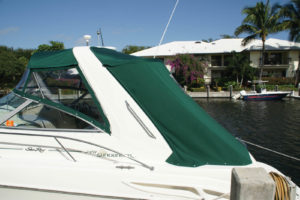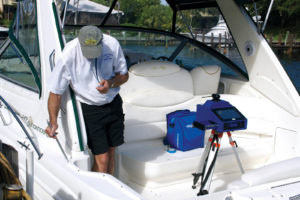Going hi-tech
Faster, better, smarter: Is there always a way to get there? Maybe. And yet it’s not easy to determine what is faster, better or smarter for any one marine fabrication shop.
Technological advancements in three-dimensional software and hardware engineering are changing the way many fabricators do business. While some programs might be cost-prohibitive for certain end users, more and more fabricators are finding options that fit their budget and enhance their bottom line.
For years, 3-D technology was off limits to most. The technology was expensive and often difficult to use. But today’s software and hardware can be found throughout a range of industries, and fabricators are learning that technology can help improve efficiency and profits. But choosing the correct equipment and software is complicated.
How it works

Fabricators are increasingly using sophisticated software and hardware technologies to improve efficiency and increase profits. Choosing the right tools, is a big part of the challenge.
Technology’s primary role in the marine fabrication industry is to simplify and standardize methods of doing work by automating manual tasks through the use of high-tech hardware and software.
Marty Crist, owner and operator of National Canvas and Upholstery in Delray Beach, Fla., takes jobs an hour away from his shop. Before that, an hour drive was too far. Now his Proliner digitizer from Prodim USA LLC lets him do a job more efficiently and more accurately.
“I can now measure boats in windy conditions and measure boats on a lift or in the water, which allows me to gain more business,” Crist says. “But the main thing is that it takes me way fewer trips back and forth to the job. I measure, fabricate and install in one shot.”

He knows the new technology is faster than a tape measure, but that’s not what matters. “It’s more than just how quickly you can measure,” Crist says. “It’s the results—and what you can do with the results after you’ve measured.”
The Proliner transforms objects into digital images. The device measures X, Y and Z coordinates by using measuring points input by the fabricator. Rendered objects lie on a flat plane or stand in 3-D.
A “pen” wired to a rotating head measures the Z axis, and the rotating head measures the X and Y axes. The fabricator places the pen on relevant points on the object. The Proliner automatically connects these points, transforming them into shapes, which are then stored as digital CAD files.
After the files are manipulated in CAD, they are imported into a cutter, which is run by software that translates files into plot paths for the cutter to follow. An individual plot path derives from a CAD file that “nests” patterns onto the cutter to allow for the best use of fabric. Once nested, the pattern is cut.
“I am able to take on more complex jobs,” Crist says. “I recently did a complicated curved back rest on a bow that would have taken too much time, so I wouldn’t have known what to charge to complete the project. I’ve also been able to take on some commercial awning projects that I would have never done before. I am a one-man shop, so efficiency is the key to success. That’s why I purchased both a Proliner and a cutting table.”
2-D vs. 3-D
Rigid enclosures illustrate the advantages of using digital technology over traditional methods. Before CAD, patterns were made manually in the shop. A pattern was placed on a table and marked, using straight edges and curved rulers.
The pattern was placed over fabric, where the borders and seam allowances were transferred by hand with the aid of tracing paper and then cut. The final step was to transfer the cut lines onto the rigid glass with a marker.
Rigid enclosures can be cut using digital equipment. Measurements are taken using a digital measuring device, the digitized pattern is refined in CAD software, and then it’s sent to the cutter.
Such cutting tables work with measuring devices, but can import data from any CAD program. A typical file for a cutting table is a “.dxf” (drawing exchange format) file that could be output from a digital measuring device, generated through custom design software or through AutoCAD software.

Marty Crist of National Canvas and Upholstery in Delray Beach, Fla., uses a Proliner digitizer from Prodim USA LLC. He says the tool lets him do a job more efficiently and more accurately.
Nesting software makes maximum use of a piece of fabric, arranging the cuts to minimize waste. Nesting is typically done on a separate computer, but some cutters offer proprietary programs with different levels of nesting efficiency. If your material is dear at $100 a square meter, for example, you may be willing to invest little bit more in a nesting program.
“Steps between going from digitizer to the cutting machine can be as simple as reimporting the .dxf file with some nesting to be done,” says Elizabeth McGruder, marketing manager with Eastman Machine Co. of Buffalo, N.Y. You can then transfer it to a flash drive and walk it over to the cutting machine.
The 3-D digitizer effectively replaces physical patterning methods. The files are uploaded to the CAD workstation and imported into Rhino software that formed the enclosure in 3-D. The software flattened the 3-D panels into a 2-D image, and then made the image into a pattern. The pattern was processed and built.
Navigating the learning curve
Like any new technology, incorporating 3-D technology into fabrication shops—both large and small—can be challenging. Not only are the software and hardware components often expensive, but there is a significant learning curve for those who are new to the technology.
Of course, after measuring comes design—running measurements through a CAD program, “flattening” 3-D shapes to 2-D, “nesting” to maximize use of fabric, and, of course, the cutting itself. Software to do all that is often packaged with measuring and cutting tools.
“Learning how to use the hardware was the easy part,” Crist says. “Becoming proficient with the CAD program took about a month, but I am always learning a new trick everyday.”
Liz Diaz, MFC, owner of North Beach Marine Canvas in San Francisco, Calif., uses a digital measuring device for boat-size projects, like a fire-damaged vessel she has been asked to help refit. It also worked well making protective covers for a party area at AT&T Park, the San Francisco Giants’ baseball stadium.
Although Diaz’s bread and butter is smaller-scale jobs such as boat cushions and upholstery, for which she prefers old-fashioned butcher paper to mark pleats, tucks and rolls, she says she is “armed and ready” for bigger projects for which her digital technology is a benefit. She says she wouldn’t have gotten the big ballpark job without it.
Before Crist purchased 3-D measuring equipment and software, he admittedly was not all that computer savvy. But he says that has changed for the better.
In his daily production as a one-man canvas and upholstery shop, he uses the latest version of a Proliner 8 with Proliner 3.1 software. After measuring a project, he imports the information and does all CAD editing with Rhinoceros software. He then uses Mpanel plugin for flattening the 3-D shapes to 2-D shapes.
Three-dimensional technology offers a tremendous number of benefits, including standardization of methods, increased speed, efficiency and accuracy, less time and labor, less paperwork, and storage of digital patterns for later use.
Trial and error
Before purchasing 3-D software and hardware systems, try it out to see if it meets your needs. Many manufacturers offer 30-day free trials. Look for workshops offered by manufacturers and the Marine Fabricators Association. Any information you can obtain is a good investment prior to purchasing.
It’s a big commitment to learn 3-D software. Start simple with the hardware. When you can understand why and what you need, then invest specifically.
As the growth of 3-D programming options continues on an upward spiral, the future of incorporating this type of technology into the marine fabrication industry is bright—and it can shine a light on your efficiency and your bottom line.
Marc Hequet and Maura Keller are Minnesota-based freelance writers.
 TEXTILES.ORG
TEXTILES.ORG 






